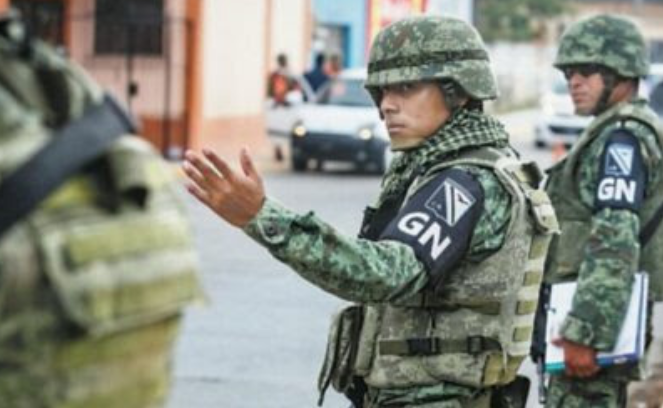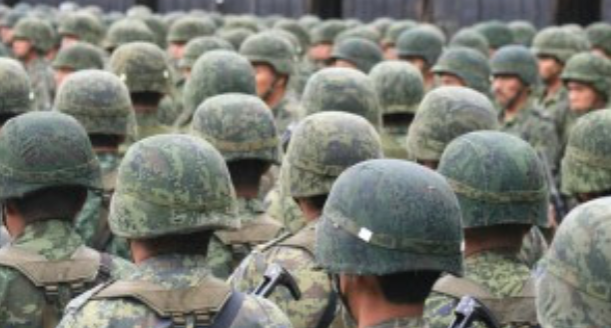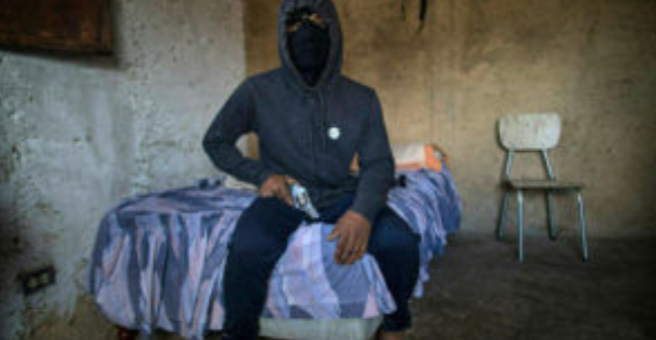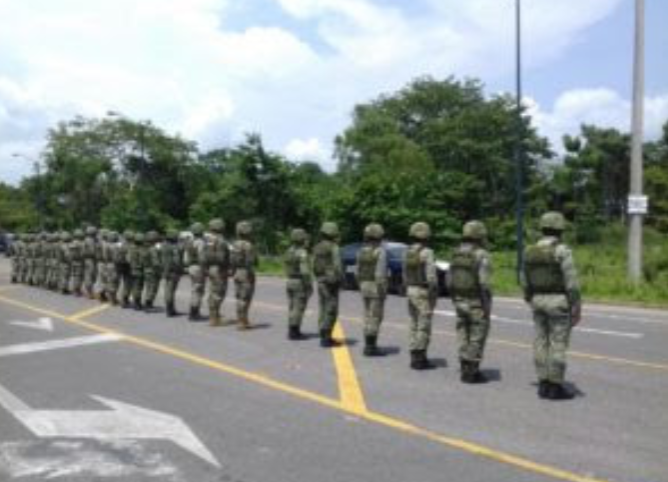
Editorial Staff: Yessica Morales
*The research offered systematization of information regarding the militarization of the Southeast and the phenomena of the presence of networks of drug and human trafficking, migration controls, or specific enterprises like real estate and tourism.
Academics* from the Latin American Observatory of Geopolitics at the National Autonomous University of Mexico (UNAM) mentioned in their research “Militarization of the Southeast of Mexico” that the Armed Forces currently have among their functions: public security, migration assignments, control of the ports, and construction of the infrastructure megaprojects like the Mayan Train.
They are occupied with the barracks for the National Guard (GN), the Banks of Well-being , and they deliver vaccines against Covid-19 and distribute textbooks. One final concession of the government was to grant them the administration and use of these works.
In this sense, the “resources that are obtained by the Mayan Train, will no longer go to the Secretary of Finance, but will go directly to the Army, and the nearly 1,500 kilometers of railroad will be the property of the Secretary of National Defense (SEDENA).”

The researchers emphasized that, according to Rogelio Jiménez Pons, head of the National Fund for the Promotion of Tourism (FONATUR), the strategy corresponds to a “nationalist vision of long-term patrimony.”
That is to say, since SEDENA owns the mega-project, it prevents it from being privatized in the future, and it is a business “for the benefit of a majority of Mexicans.” In addition, the Mayan Train becomes a “national security factor” because of the presence of organized crime in these areas.
“What is notable is that, with the fragility of the current government, the military establishment has acquired excessive constitutional powers that in other moments of history used to be won only by means of coups d’état,” said the academics.
They considered that government interest in the region was to promote a series of megaprojects of high socio-environmental impact in times of ecological emergency, and despite the valuable and astute arguments against, they noted with concern that there is no intention of stopping the works.
They added that, despite the demonstration of its predatory nature, and of complicating the conflict, [the megaprojects] will not be possible without extensive militarization of the zone which is already underway. But, it points to a more permanent establishment with the multiplication of cuartels and deployment of troops, which puts society, cultures, histories and treasures of the rich lands of the southeast at risk.
The academics indicated that the trafficking of drugs has been one of the strong arguments to justify military deployment, not only in general, but in some specific regions of the country. However, they revealed facts and testimonies about the rise in regional violence with military participation, whether it be directly or indirectly, as with their complicity with organized crime.
What is demonstrated on a daily basis is the intervention of the armed forces in the control and repression of populations, in tasks of forced territorial reorganization or in counterinsurgency operations, said the researchers.
A Progressive Militarization

The academics highlighted that by May 2020, the National Guard was made up of 50% military police from SEDENA, 10% naval police from the Secretary of the Navy (SEMAR), 20% Federal Police, and 17% new recruits hired by SEDENA and SEMAR, trained in military bases.
What is more, they explained that on August 13, 2021, the restructuring of the Armed Forces outlined and announced since the arrival of Andrés Manuel López Obrador, President of Mexico, was approved, and that it corresponds to the materialization of point 3.1.8 of the National Defense Sector Program 2020-2024, entitled “Developing the project for the creation of the Army Command and its General Staff.”
They explained that the creation of a new area is supported by articles 14, section IX, and 17 of the Organic Law of the Mexican Army and Air Force where “it is hereby ordered and authorized to implement the necessary actions to create the Command of the Mexican Army, in order to contribute to the training, administration and development of the armed force for the benefit of our nation.”
Cartel Presence along the Tren Maya route and Processes of Violence

The researchers mentioned that the consulting firm Stratfor established that in the states where the Mayan Train will be implemented, two dynamics prevail: the first is that in Chiapas, Tabasco, Yucatan, Campeche and a portion of Quintana Roo, there is a dispute between remnants of the Gulf Cartel and Los Zetas.
The second describes that, in the areas of greatest tourist activity in Quintana Roo associated with the Riviera Maya, both the larger and more consistent organizations – the Sinaloa Cartel and the Jalisco Cartel – New Generation (CJNG) – and remnants of others – Los Zetas – are involved.
“Recent investigations have detected the presence of the CJNG in the strip that goes up from El Salvador to Chiapas, which for the moment are dealing in business other than drug trafficking so as not to attract the attention of the US Drug Enforcement Agency,” the scholars mentioned .
Other phenomena of violence add to this, such as assaults on women and femicides, both of which are associated with economic activities linked to infrastructure megaprojects and some of their specific modalities, such as hydrocarbon extraction and transportation, or tourism. Not to mention also, that different points of the Peninsula, Chiapas and Tabasco stand out in the trafficking route of girls, boys and women for labor and sexual exploitation.
Chiapas: Tourism, Violence and Militarization

Photo: Courtesy
The experts specified that, in Chiapas, the processes of violence are associated with its position as a migratory route and the growing presence of criminal economic structures that control these movements, and that dispossess and brutalize the migrant populations.
At the same time, they mentioned that the implementation of social programs such as Sembrando Vida has been taken advantage of by criminal groups to extort the population that obtains these benefits. They have reported cases of kidnapping and recruitment of migrants by these organizations on the southern border.
“Although the aforementioned problems have no place in the area where the Mayan Train will be implemented (Northern Zone), they are expected to deepen due to the markets that will be opened attracting illicit activities. Even so, the actions of armed groups, in a context of increasing violence, have provoked a forced internal displacement in the state of around 10,000 people since 2006 to date,” indicated the researchers.
Another report points out that Oaxaca and Chiapas represented 87% of forced displacement in the country in 2018, of the total estimated for this year, 45 percent corresponds to indigenous people.
Militarization of Human Migration Routes
Currently, militarization in human migration routes is one of the issues of concern, since the deployment of forces to control the migratory flow has been a constant, academics exposed.
The above, since the Donald Trump administration, in May 2019, urged Mexico to stop migration with the threat of imposing progressive tariffs on all Mexican products crossing into the northern country.
They revealed that the deployments of the National Guard in migratory situations have had a serious impact on the safeguarding of human rights of the migrant population, which has been clearly flouted by difficulties in accessing state services, the overall implementation and conditions of their detention, and the situation of insecurity and xenophobia.
The National Human Rights Commission (CNDH) issued a series of recommendations against abuses of the migrant population committed by this new force.
In Recommendation 50/2020, the autonomous organization pointed out that the National Migration Institute (INM) violated the legal rights and protections of the victims, as the National Guard “overstepped its bounds” when dealing with the inspection and detention of people in the process of migration.
On the other hand, they mentioned that Luis Cresencio Sandoval, head of SEDENA, in his visit to Chiapas last August 28, stated that the Mexican Armed Forces had completed “a series of operational activities” on the southern border that had as its “main objective to stop all migration,” so that throughout the state there were “more than 14 thousand elements of the Army, the Navy and the National Guard” carrying out the operations.
In turn, the Ibero-American University through its Citizen Security Program, presented an analysis of data obtained by requests for access to information, revealing that between June 2019 and December 2020 the Armed Forces and the National Guard detained 152 thousand migrants at the southern border of the country.
In the same period, the Migration Policy Unit reported that 193,640 migrants were presented before the migration authority, which suggests that “more than 78 percent of the detentions of migrants in Mexico during this period were carried out by the military or elements of the militarized National Guard.”
The investigators affirmed that, from data provided by the head of SEDENA during the visit, they know that in Chiapas there are 10 National Guard barracks, located in Villaflores, San Cristóbal de Las Casas, Tonalá, Huehuetán, Tapachula, Chilón, Las Margaritas, Frontera Comalapa, Bochil and Palenque.
Finally, they added that next year there will be 6 more barracks in Cintalapa de Figueroa, Arriaga, Acacoyagua, Altamirano, Palenque and Solistahuacán.
*Academics:
- Ana Esther Ceceña
- David Barrios
- Alberto Hidalgo Luna
- Sandy Ramírez
- Yetiani Romero
- Adriana Franco
- Bianca Bachelot
- Melissa López
- Alma Daniela Garduño
This text was published in Chiapas Paralelo on October 5, 2021. https://www.chiapasparalelo.com/noticias/chiapas/2021/10/entre-militares-y-carteles-academia-reflexiona-incremento-de-violencia-en-el-sureste/ English interpretation by Schools for Chiapas.
